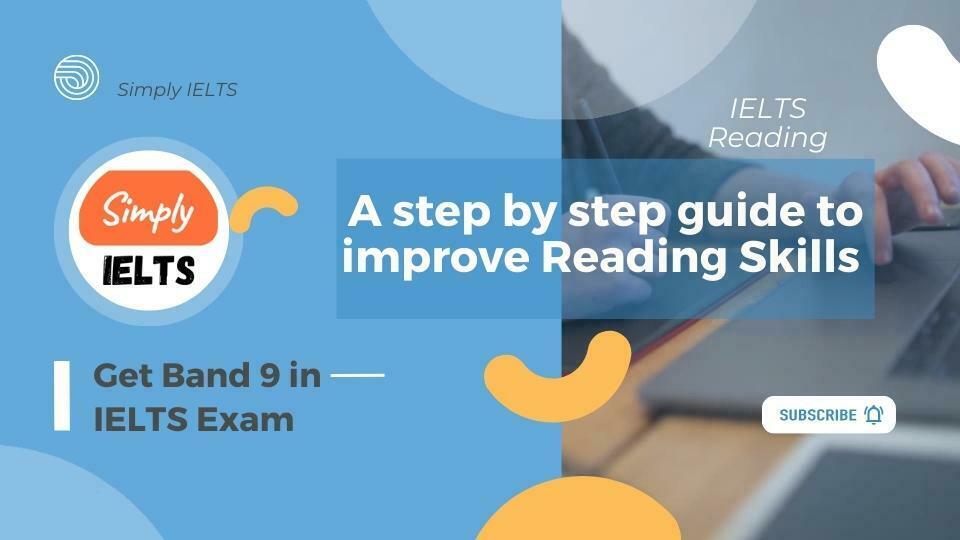A step by step guide to improve Reading Skills and IELTS Reading scores

Many students are frustrated by their IELTS reading scores. They wish to improve it but cannot answer all 40 questions in 1 hour.
On the one hand, IELTS Academic students struggle to read the long academic passages with unknown topics.
On the other hand, General Training students work to concentrate on the given subject matter as they are reading such information after a long gap.
Here, we will explore the reasons why you fail on IELTS Reading, how you can enhance your reading skills and eventually how you can increase your IELTS Reading scores.
To improve your reading skills and IELTS reading scores,
- Improve your reading habits.
- Know the question types on IELTS Reading and the strategies to solve them.
- Master scanning and skimming techniques.
- Avoid re-reading the passage.
- Be confident about your final answers if you have followed the technique well.
Basics of IELTS Reading section
Number of parts = 3
Number of questions = 40
Total time = 60 minutes
Many students ask us how to manage time on IELTS Reading? Well, the answer to this question is precisely the same as that we are going to discuss in this rest of the discussion.
Step 1: Improve your reading speed to solve all questions on IELTS Reading section
Most IELTS students are slow readers. Surprised? Read further.
Slow reading speed leads to failure on IELTS Reading tests.
On an average, each part of the IELTS Reading section (both on Academic and General Training) has about 700 to 800 words to read. I am not even counting the number of words in the questions.
Additionally, from observation, each part has about 200 words in questions.
So, overall, you may read about 1000 words in one part of the IELTS Reading test. So, on average, you may read about 3000 words on any Reading paper.
Now, from our observation, we can safely say that most students read hardly 100 words per minute. So, you can imagine that most of us spend 30 minutes reading the whole question paper only once. Many may think that this is acceptable. But think about it again.
To solve any question on the IELTS Reading section, you must read the question, understand what it is asking, find the answer in the passage carefully, think whether you are right or wrong and then write the answer. So, in a way to do all these things, you are left with hardly 30 minutes. That is 40 questions in 30 minutes. It means you have 45 seconds for each question. Scary! Right?
Ways to improve your reading speed
There are many ways to increase your reading speed. However, here are a few tips.
Stop saying the words in your mind.
As a child, your teacher asked you to say words in your mind while reading. And an obedient child that you are, you have still maintained the same style of reading. I hope as you are reading this, you will hear your voice reading these words. STOP it.
If you speak the words silently in your mind as you read your speaking and reading speed is the same. So, stop this habit right now.
We process chunks of words and not one word at a time.
Many of us, unfortunately, read one word at a time. However, it has been observed that we can process phrases together. If you start reading these chunks of words together, you will improve your reading speed for sure.
If you are serious about increasing your reading speed, I would recommend a book called “How to read better and faster” by Norman Lewis. It takes you to step by step through the best reading practices.
How does reading fast improve your IELTS Reading scores?
I guess now it is simple mathematics for you. The fast you read the more number of questions you can answer confidently. The more number of problems you solve, better is your IELTS Reading score.
Step 2: Know all question types on IELTS Reading and strategies to improve scores
If you don’t know your enemy, you cannot win the war.
Now, for many of us, IELTS is like a war. And, yet most students have no idea about the kind of questions they should expect on the IELTS Reading. Well, if you don’t know the sort of questions, then everything is a surprise for you in the actual test.
Learn about question types on IELTS Reading section
On the other hand, if you know all the question types, you can analyse what is expected on each of those. You can also notice specific patterns to trap you. And accordingly, you can develop a strategy. Once you have a particular strategy for each Reading question set, you can be more confident about your answers.
If you want to learn more about the kind of questions and strategies to solve them, refer to the following list.
- Note-Taking Question
- Matching Heading Question
- Matching Features question
- True / False / Not Given question
- Summary Completion question
- Table completion question
Step 3: Master scanning and skimming instead of direct reading to improve IELTS Reading.
Now, you may have heard of these reading practices. Even if you have never heard of it, don’t panic. Under pressure, most of us don’t trust these techniques anyway. I have seen many students ditch them in mock tests and resort to old habits. Well, trust them.
Now, let us explore scanning and skimming techniques with a simple example.
Scanning
Let’s say you want to buy an office chair for your home office. So, you visit a shopping mall. Now, after reaching the furniture section, do you start evaluating each piece of furniture on the way? No, not at all. You quickly gaze through the area to spot where exactly chairs are kept. You ignore the rest. This process is scanning.
While scanning a passage, you know what you wish to read about. It could be a specific scientist or a particular year when an individual event took place. You just roll your eyes over the words to find what you were looking for. This helps you to be very objective while searching for answers and saves time.
Skimming
Now let’s continue the experience of buying an office chair. Once, you spot a section for all chairs, do you usually try each chair? No. Instead, most of us turn towards the sales professionals and convey the list of features you wish for. Accordingly, most salespeople shortlist two or three chairs for you. Now, what happened here was you got the gist of all the relevant chairs.
Similarly, while reading it is essential to speed read through the passage to find the gist of the whole paragraph. Understanding the essence of the paragraph offers us confidence while searching for answers since logically, we can predict whether the answer to an IELTS Reading question would lie in it or not.
An example to learn about skimming and scanning in IELTS Reading
Now to make my point clear, consider the following paragraph. It has 94 words.
Now, try and finish the section in 30 seconds. Put on the timer and skim.
As 2020 approaches, make the new year and new decade the time to turn heads in your profession by boosting your leadership skills and making a commitment to your professional fitness doesn’t have to take a bite out of your bottom line, either. The Professional Development Academy, an online leadership training company with top-notch faculty from business, industry, and the government offers programs in areas including high-performance leadership, frontline information technology leadership, and maximising your brand, all for a fraction of the cost of a traditional MBA program and easily accessible at your convenience.
Now can you tell me what the paragraph is about? Yes, it is introducing a new management course to the reader. See, this is skimming. You quickly tried to find the summary of the paragraph soon.
Further, can you tell me if this new programme is costlier than the conventional MBA programme? Now, to find the answer, you realise you quickly need to locate the keywords MBA in the paragraph. These words lie in the last line. Once you encounter these words without reading anything seriously, you can read that one sentence to answer the question comfortably. This is scanning.
After understanding how to improve reading skills, let’s discuss how to implement them to enhance your IELTS Reading scores.
Step 4: Don’t re-read unnecessarily and lose your confidence in IELTS Reading section
While reading hard sentences, we often read difficult words and sentences twice to understand what the author has to say.
Additionally, let’s admit one more thing that each of us cannot remember everything that we read the first time we read it. After reading the question, even if we know the answer, we must confirm it by re-reading the passage.
From the previous paragraph, we have seen that it takes 30 minutes to read everything once. So, when you read the same passage twice let’s say you may take half the time as you already know the location of the answer. However, you waste additional 15 minutes rereading.
Effectively most of us take about 45 minutes to read, leaving hardly 15 minutes to process 40 questions.
How to avoid re-reading?
I mean, there is no easy way to say this. Don’t re-read. But I know its easier said than done. So, initially, use your fingers to track what you are reading. I know it may look childish. But don’t allow yourself to retract the finger. Even if you do this, your mind will automatically retain more information increasing your reading efficiency.
Step 5: Don’t overthink your answers on IELTS Reading.
Re-reading to confirm answers leads to more confusion on IELTS Reading section.
After working on the tips mentioned above, most students start performing well. However, another issue that creeps up is an interesting one. When students start getting correct answers after learning the strategies, many want to re-confirm by re-reading the passage as they cannot believe that they could get answers so quickly. Such indecisiveness leads to confusion.
Many times students change their answers, and more often than not, these revised answers are the wrong ones.
Believe in the process and your answers on IELTS Reading.
Once you are convinced by your strategies and reading skills, don’t re-read the passage and change answers.
Understand it is one thing to be worried about one or two tough questions, and it is another to re-confirm every answer.
So, I suggest believing in the process and strategies once you implement them.
What if I get my answers wrong after I stop rechecking my answers on IELTS Reading?
Well if you still get your answers wrong, then observe your decision-making process. It could happen that your interpretation of a sentence was incorrect. Or it could also happen that you haven’t followed the instructions given to you while writing the answers. Once you identify the weakness, work on it.
I sincerely hope that you have understood how to tackle the IELTS Reading section. Best luck.



Responses